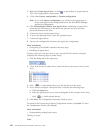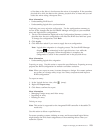
4. An integrated RAID controller supports a maximum of one logical
drive.
Possible
subobject
v
(Logical drive)
Warning
and error conditions
v None.
Actions
v Delete > logical drive number
v Identify all logical drives
v Configure access control list (networked storage only)
v Configure target information (networked storage only)
Understanding
when RAID level-x0 logical drives change state: Start with four
physical drives.
Use two physical drives to create array A and two physical drives to create array
B.
Use arrays A and B to create spanned array 1. As part of a spanned array, arrays A
and B are now called ″subarrays.″
A sub-logical drive is created in array A and another sub-logical drive is created in
array B.
Then, create a logical drive in spanned array 1.
If the sub-logical drive in subarray A is in the okay state and the sub-logical drive
in subarray B is in the okay state, then the logical drive in spanned array 1 is in
the okay state.
If a physical drive fails in subarray A, then the sub-logical drive in subarray A
changes to the critical state. Subarray B is still in the okay state. The logical drive
in spanned array 1 changes to the critical state.
If the second physical drive fails in subarray A, then the sub-logical drive in
subarray A changes to the offline state. Subarray B remains in the okay state. The
logical drive in spanned array 1 changes to the offline state.
If the sub-logical drive in subarray A is in the critical state and a physical drive
fails in subarray B, then the sub-logical drive in subarray B changes to the critical
state. With both sub-logical drives in the critical state, the logical drive in spanned
array 1 remains in the critical state.
More information
v Understanding creating spanned arrays
v Creating spanned arrays in the wizard
v Understanding RAID level-x0
v Physical drive capacity and unusable capacity
v Understanding creating basic arrays
126 ServeRAID Manager Installation and User's Guide


















